At Building Consultancy & Inspections (having performed over 30,000 inspections) we have found that one of the biggest or most serious concerns for purchasers is the presence of asbestos-containing material (ACM) at the inspection site.
ACM was extensively used in Australian products from the 1930s until about 1987 when its use ceased in the building industry, followed by a total ban on manufacture, use, reuse, import, transport, storage or sale of all forms of asbestos (including white) in December, 2003.
In Western Australia many pre-1990 residential and commercial buildings (possibly up to 75%) may contain asbestos, mainly as cement sheeting used in walls, ceilings, eaves, fences and roofs. Some houses built in the 1990s and early 2000s may have still used a ACM until the total ban on any activity involving asbestos products became effective. If a residential property or its structures were built before 1990, it is recommended that it be assessed for the presence of ACM. This will then allow management actions to be taken if any ACM is in poor condition or may be disturbed by subsequent activities such as cleaning, repairs, renovation or demolition.
If you are considering a renovation that involves disturbing large amounts of ACM, removing friable asbestos products, or demolition of all or part of your property, don’t do this work yourself. Engage a licensed asbestos removalist who knows how to manage this work safely, and without risk to you or your neighbours.
Asbestos-related diseases incidence has steadily grown, resulting in Australia having one of the highest rates of mesothelioma in the world. Most of these diseases were due to high levels of asbestos exposure in the associated mining, milling and installation industries. However, in more recent times asbestos-related diseases are increasingly occurring among building maintenance workers such as carpenters, electricians and plumbers, and members of the public undertaking home renovations personally.
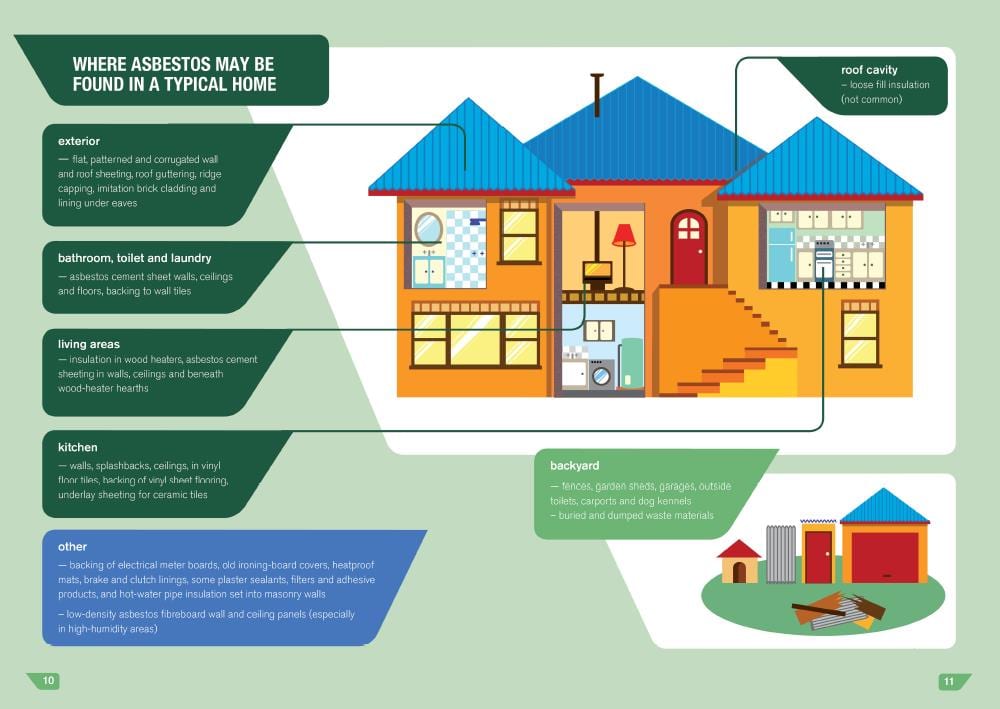
SO, WHAT IS ASBESTOS?
Asbestos is the name given to a group of naturally occurring minerals found in rock formations. Its fibres are strong, heat resistant and have insulating properties. Clumps of mined asbestos can be broken down into loose fibres or fibre bundles and can be mixed with other materials, such as cement, to produce a variety of building products. The fibres are not visible to the naked eye and, as they are very light, remain airborne for a long time. Fibres can be found in the air from the breakdown of natural asbestos deposits and manufactured asbestos products. Once airborne, small fibres may remain suspended in the air for some time and can be carried long distances by wind before settling down. Larger fibres and particles tend to settle more quickly. Asbestos fibres do not dissolve in water or move through soil. They are generally not broken down to other compounds and remain virtually unchanged over long periods.
Asbestos-containing building products are classified as either ‘friable’ (soft, crumbly) or ‘bonded’ (solid, rigid, non-friable).
Bonded Products:
Bonded asbestos products are made from a bonding compound (such as cement) mixed with a small proportion (usually less than 15%) of asbestos. They are solid, rigid and non-friable. The asbestos fibres are tightly bound in the product and are not normally released into the air. Common names for such products are ‘fibro’, ‘asbestos cement’ and ‘AC sheeting’.
When in good condition, these products do not normally release any fibres into the air and are considered a very low risk for people who are in contact with them if appropriate safety precautions are used when they are disturbed. Undisturbed asbestos cement materials in good condition do not pose a health risk because the fibres are bound together in solid cement. However, bonded asbestos products may become friable when sufficiently damaged, badly weathered (including hail damage), or otherwise deteriorated.
Most asbestos-containing products used in houses were bonded asbestos cement materials, including:
- * roofing
- * shingles and siding (villa board and similar)
- * exterior and interior wall cladding
- * eaves
- * fencing
- * thermal boards around fireplaces
- * water or flue pipes.
Friable Products:
Friable asbestos products are generally quite soft and loose and can be crumbled into fine material or dust with very light pressure, such as crushing with your hand. Such products usually contain high levels of asbestos (up to 100% in some instances), which is loosely held in the product. These products are dangerous because the fibres can get into the air very easily and may be inhaled by people living or working in the vicinity. Asbestos only poses a risk to health when its fibres are breathed in.
Some friable asbestos products may also be found in houses, including:
- * asbestos-rope door gaskets in wood stoves
- * loose fill roofing insulation (not common)
- * spray-on insulation or soundproofing
- * low-density asbestos fibre board
- * insulation on hot-water pipes, domestic heaters and stoves (e.g. lagging)
- * backing material on floor tiles and vinyl flooring
- * carpet underlay (not common)
- * textured paints, decorative ceiling coatings
- * heat-resistant fabrics
- * brick and plaster sealants, fillers and some adhesive products
- * hail or fire damaged, or badly weathered asbestos cement materials.
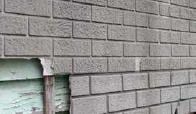

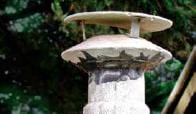
‘Brick’ cladding Sheeting in eves Flue and cowl


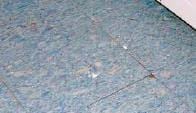
Shingles Garage Gable Old vinyl floor tiles
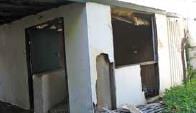
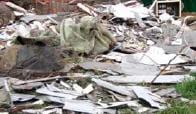

Disused outbuilding Broken materials Corrugated roofing
HOW DO I KNOW IF A MATERIAL IN MY HOUSE CONTAINS ASBESTOS?
It is not possible to confirm whether a material contains asbestos simply by looking at it. Careful, close examination of a sample using specialised microscopic procedures is the only way to tell and it is best for this to be done at an accredited laboratory. If you know the suspect material was installed before 1990, it is safest to assume it does contain asbestos. If in doubt, get it tested.
The National Association of Testing Authorities (NATA) can provide details of an accredited laboratory in your area where asbestos can be identified accurately. Alternatively, contact a licensed asbestos removalist to arrange testing of suspect material by an accredited laboratory. There is a modest cost for testing, which varies between laboratories.
To find a NATA accredited asbestos analytical laboratories search for asbestos at: http://www.nata.com.au/nata/orgs-and-facilities/advanced-facilities-search WorkSafe (WA Department of Commerce).
For information and advice on asbestos in relation to public health contact the Department of Health, Environmental Health Directorate on 08 93884999, mailto:ehinfo@health.wa.gov.au or at the website: https://www.public.health.wa.gov.au/3/1143/2/asbestos_and_public_health.pm.
https://www.commerce.wa.gov.au/worksafe/asbestos-information-asbestos-workplace

